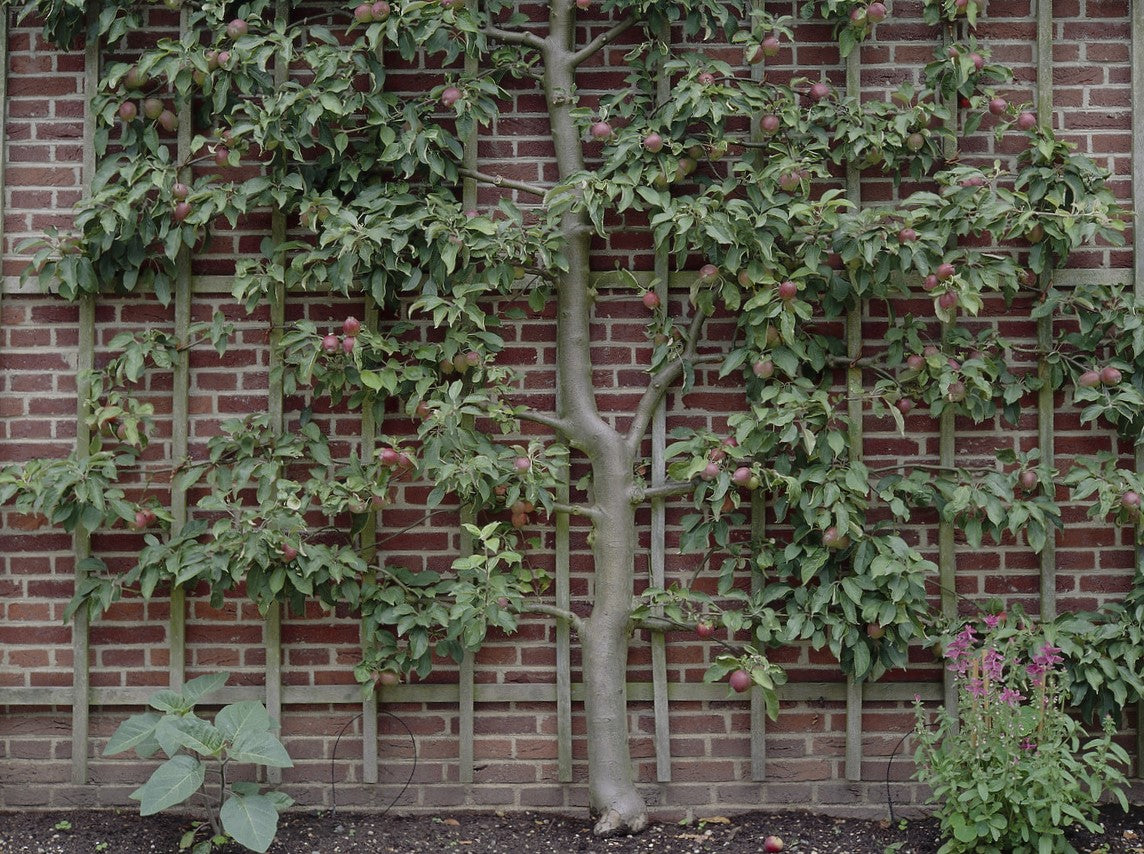Advice & Inspiration
Stepover Apple Trees: The Complete Guide

Stepover apple trees can be a great way of saving space in your garden and they look really impressive. They’re becoming increasingly popular, but how do you train them and is it worth it? Step over here for everything you need to know.
What are stepover apple trees?
Stepover apples are apple trees on a miniature rootstock that have been trained into a very low, straight-edged form - basically a one tier espalier. They’re usually grown to a height between 45-60cm - so low you can step over them.
Why grow stepover apples?
Growing stepover apples is an attractive and space-saving alternative to a low fence or wall. They take up space that may otherwise be unproductive, producing normal sized fruit without blocking light from the rest of your patch. They also look amazing in springtime when the blossom is out, and provide a useful habitat for birds, bees and other pollinators. Stepovers were traditionally planted around kitchen gardens and allotments, where the blossom would attract pollinators to the fruit and vegetable plants, but they can also work well as edging for a lawn, path or borders. They’re less productive than regular apple trees and they do need a lot of pruning to keep them in shape, but if you like a challenge, it’s well worth it!
Suitable varieties for stepovers
For a stepover apple tree, you’ll need a very young tree (one year old) - or maiden whip - with very few or no side branches. It needs to be a spur bearing variety on an M27 or M26 miniature rootstock - anything else would be too vigorous. Spur bearing means that the tree produces fruit on short branched shoots of older wood nearer the trunk. This makes them ideal for training as you can safely prune the ends of the branches without losing fruit. Some suitable spur bearing varieties are Bountiful, Braeburn, Cox’s Orange Pippin, Dabinett, Falstaff, Fiesta, Gala, Golden Delicious, James Grieve, Jonagold, Katy, Laxton’s Superb, Red Devil, Red Windsor, Rubinette and Spartan.

How to grow a stepover apple tree
Planting
Late autumn or winter is the best time to start off your stepovers, when you can use bare root trees. You’ll need to prepare a support system first. Hammer in strong support posts about 60cm high and 1.5m apart. Then attach horizontal wire between them, 45cm from the ground. Choose a day when it’s not too wet and the ground isn’t frozen. Plant each young tree next to a post and secure it with a tree tie fastened loosely in a figure of eight shape to allow for growth.
Training
There are two ways to train a stepover - starting the spring after planting, choose the method that works best for you. (I also recommend watching this video for more guidance.)
The cordon method
Start to gently bend the leaders (the main stems) of the trees down towards the horizontal wire. Tie them to the wire at several points along the stem so that they grow evenly. Do it gradually - you’ll need to keep bending and tying in the leaders throughout spring and summer as the trees grow. It looks really neat if you can get the tip of the leader to touch the trunk of the next tree along.
The espalier method
This is the way to go if your young trees aren’t bendy enough for the cordon method. Simply cut off the tree stem just above a good strong bud at around the 30cm mark. The arms will form from this bud to form a T shape - they can then be tied into the wire.
Pruning
The spring after that, let three shoots form at the top of the stem. Over the summer, choose the two strongest ones and gently train them along the wire, tying them in as you go. Prune the third shoot to one bud and rub off any buds on the stem below the arms. Once the arms get to about 60cm long (or get to the end of the wires), prune them down to one strong bud. You should end up with a low, t-shaped tree. Each summer after that, prune any new growth from the arms to three leaves above the lowest cluster of leaves on a shoot and trim any side shoots down to one leaf.
More ways of training trees
Stepovers are just the start! Check out our guides to espalier training apple trees and training your trees as cordons and fans.

Header image courtesy of Wikimedia.





















